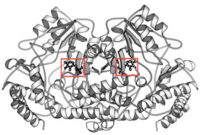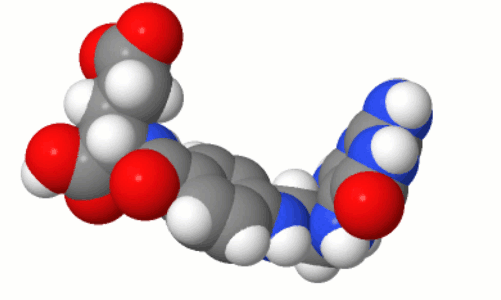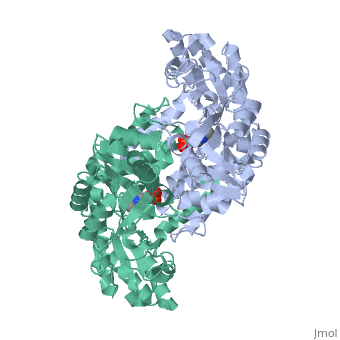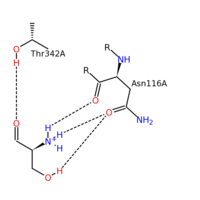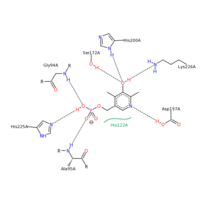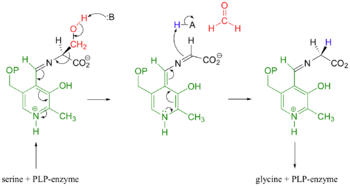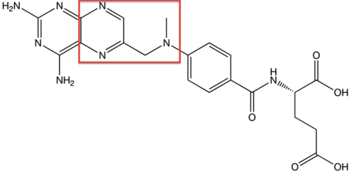Serine hydroxymethyltransferase
From Proteopedia
Contents |
Introduction
Diversity/Importance
Serine hydroxymethyltransferase (SHMT) is a ubiquitous enzyme that is found in all prokaryotes and eukaryotes. SHMT has a total molecular weight of ~46kD. Each monomeric unit of SHMT has a molecular weight of ~23kD.[1]There are multiple isoforms of the SHMT enzyme. Serine hydroxymethyltransferase isoforms have namely been identified from Escherichia coli and Bacillus stearothermophilus. The diverse presence of serine hydroxymethyltransferase is in part because of the importance of 5,10-methylene tetrahydrofolate in one-carbon metabolism, where it is a substrate of various enzymes such as thymidylate synthase and methylenetetrahydrofolate reductase. The methylene group in 5,10-methylene tetrahydrofolate is important for the synthesis of the essential biomolecules purine, thymidine, choline, and methionine. Serine hydroxymethyltransferase deficiencies have been linked to Smith-Magneis syndrome (SMS).[2] Also, SHMT inhibitors are being evaluated as potential anti-cancer and anti-microbial drugs.[3] In eukaryotes cystolic SHMT is called
- SHMT 1 is found in eukaryotes.
- SHMT 2 is found in mitochondria. It is a PLP-dependent enzyme catalysing the reversible transformation of serine to glycine[4]
Function
This enzyme is part of the one-carbon metabolism and employs pyridoxal phosphate (PLP) as prosthetic group. The enzyme is broadly classified as a transferase enzyme. Transferase enzymes primarily work by catalyzing the transfer of a specific functional group from one molecule to another. This enzyme is utilized mainly for two functions. First, the enzyme catalyzes the reversible conversion of L-serine to L-glycine. Second, the enzyme catalyzes the reversible conversion of tetrahydrofolate to 5,10-methylene tetrahydrofolate. Although the enzyme's purpose is the interconversion of these molecules, the reactions occur within the same chemical mechanism. The interconversion of both molecules is diagrammed below in Enzymatic Function of SHMT. The ribbon diagram shows the dimeric form of "Bacillus stearothermophilus", which is the the native state of the enzyme. The two red box annotations show the ligand binding sites within each monomer. Within each monomer, the pyridoxal-5'-phosphate (PLP) binds within a divot between the two domains. PLP is covalently bound to serine hydroxymethyltransferase.The incorporation of a carbon into tetrahydrofolate changes its shape. The methylene group is part of a newly formed ring, changing the bent shape of tetrahydrofolate into a more elongated flat conformation near the 5 and 10 nitrogen atoms. In the aimation above, the overall structure is shown as spacefilling, with the methylene carbon in black. The detail of the ring closure is shown as ball-and-stick, with nitrogen N5 and N10 labeled in both structures.
| |||||||||||
References
- ↑ 1.0 1.1 1.2 1.3 1.4 1.5 Trivedi V, Gupta A, Jala VR, Saravanan P, Rao GS, Rao NA, Savithri HS, Subramanya HS. Crystal structure of binary and ternary complexes of serine hydroxymethyltransferase from Bacillus stearothermophilus: insights into the catalytic mechanism. J Biol Chem. 2002 May 10;277(19):17161-9. Epub 2002 Feb 27. PMID:11877399 doi:10.1074/jbc.M111976200
- ↑ Elsea SH, Juyal RC, Jiralerspong S, Finucane BM, Pandolfo M, Greenberg F, Baldini A, Stover P, Patel PI. Haploinsufficiency of cytosolic serine hydroxymethyltransferase in the Smith-Magenis syndrome. Am J Hum Genet. 1995 Dec;57(6):1342-50. PMID:8533763
- ↑ Renwick SB, Snell K, Baumann U. The crystal structure of human cytosolic serine hydroxymethyltransferase: a target for cancer chemotherapy. Structure. 1998 Sep 15;6(9):1105-16. PMID:9753690
- ↑ Xie M, Pei DS. Serine hydroxymethyltransferase 2: a novel target for human cancer therapy. Invest New Drugs. 2021 Dec;39(6):1671-1681. PMID:34215932 doi:10.1007/s10637-021-01144-z
- ↑ Grados OB. [The laboratory in programs for enteric infection control]. Bol Oficina Sanit Panam. 1975 Apr;78(4):318-22. PMID:123456
- ↑ doi: https://dx.doi.org/10.1021/acscatal.8b02321
- ↑ Grados OB. [The laboratory in programs for enteric infection control]. Bol Oficina Sanit Panam. 1975 Apr;78(4):318-22. PMID:123456
- ↑ Schirch V, Szebenyi DM. Serine hydroxymethyltransferase revisited. Curr Opin Chem Biol. 2005 Oct;9(5):482-7. PMID:16125438 doi:http://dx.doi.org/10.1016/j.cbpa.2005.08.017
- ↑ Renwick SB, Snell K, Baumann U. The crystal structure of human cytosolic serine hydroxymethyltransferase: a target for cancer chemotherapy. Structure. 1998 Sep 15;6(9):1105-16. PMID:9753690
- ↑ Elsea SH, Juyal RC, Jiralerspong S, Finucane BM, Pandolfo M, Greenberg F, Baldini A, Stover P, Patel PI. Haploinsufficiency of cytosolic serine hydroxymethyltransferase in the Smith-Magenis syndrome. Am J Hum Genet. 1995 Dec;57(6):1342-50. PMID:8533763
Proteopedia Page Contributors and Editors (what is this?)
Coleman Calva, Michal Harel, Karsten Theis, Alexander Berchansky, Jaime Prilusky
